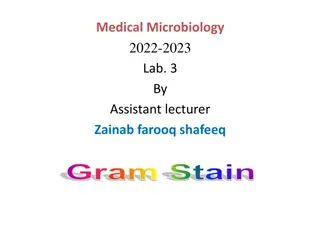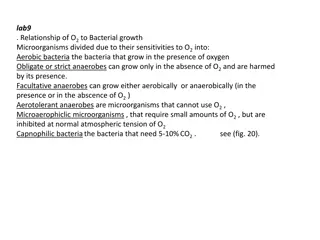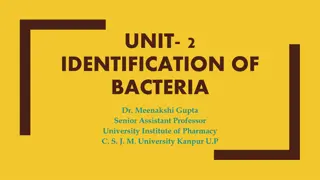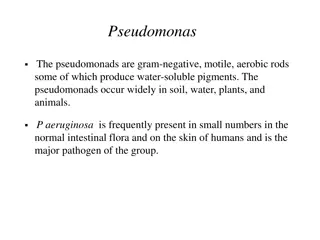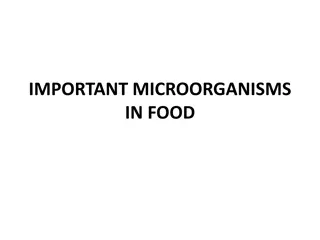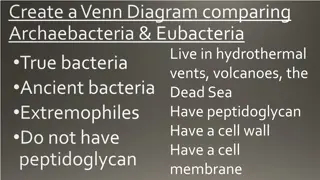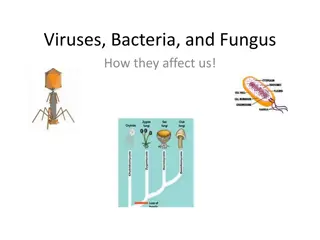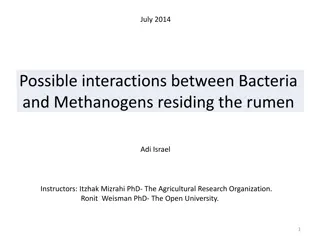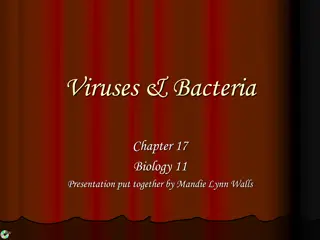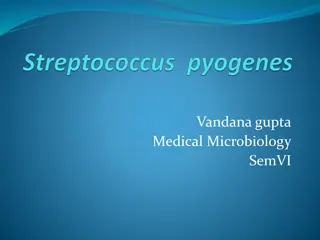Overview of Streptococcus Bacteria and Classification
Streptococcus is a genus of gram-positive bacteria commonly found on skin and mucous membranes. It includes pathogenic and non-pathogenic species, with cell division along a single axis forming pairs or chains. The bacteria were first observed by Billroth and named by Ogston. Different types of streptococci exhibit varying hemolytic properties, categorized as alpha, beta, or gamma based on their effects on red blood cells.
Download Presentation

Please find below an Image/Link to download the presentation.
The content on the website is provided AS IS for your information and personal use only. It may not be sold, licensed, or shared on other websites without obtaining consent from the author. Download presentation by click this link. If you encounter any issues during the download, it is possible that the publisher has removed the file from their server.
E N D
Presentation Transcript
GENUS STREPTOCOCCUS Dated-09/12/2020 2ndyear professional course Dr. Sudha Kumari Assistant Professor Department of Veterinary Microbiology Bihar Animal Sciences University, Patna
Streptococcus Streptococci Streptos ( twisted or coiled ) Pathogenic and non-pathogenic species may be present on the skin and on the mucous membranes of the genital ,upper respiratory and digestive tracts.
Streptococcus is a genus of gram-positive coccus or spherical bacteria that belongs to the - family -- Streptococcaceae, Oder-- Lactobacillales, phylum -- Firmicutes. Cell division in streptococci occurs along a single axis, so as they grow, they tend to form pairs or chains that may appear bent or twisted.
Billroth-first sawcocci chains in erysipelas & wound infections, called them streptococci. Ogston- Isolatd,described pathogenicity, named as streptococcus pyogenes.
Some spe. of strep. Strep. aureus Streptococcus pyogenes Streptococcus agalactiae Strep. Dysgalactiae Strep. Bovis Strep. Suis Strep. Porcine Strep. uberis (bovine mastitis) Strep. Zoo epidemicus Strep. canis
Classification (Co2 requirement)/ heamolysin production Alpha Produce greenish discolouration with partial hemolysis around the colonies. Zone of lysis is small(1-2cm wide)with definite margins, unlysed RBC scan be marked out microscopically within this zone-known as Viridians streptococci viridis=green. Normal commensals in throat---opportunistic infection Str.pneumoniae/pneumococcus is also an alpha hemolytic one. eg. Streptococcus pneumoniae,.
Beta-produce sharply defined ,clear colourless zone of hemolysis,2- 4cm wide, within which red cells are completely lysed. hemolytic Streptococci =beta hemolytic Beta-hemolysis ( -hemolysis) is defined as the complete lysis of hemoglobin of red blood cells surrounding the colony on blood agar. eg. Streptococcus pyogenes Gamma- Non haemolytic streptococci-produce no change in medium- so called indifferent streptococci ---includes faecal(enterococci,strept.faecalis). And related species-called enterococcus group.
Hemolytic classified on carbohydrate C antigen on the cell wall- Lancefields grp-20-A-V,without I&J. Grp A-Strpt.pyogenes-into types-based on proteins-M,T,R Griffith typing. A blood agar plate displaying gamma hemolysis actually appears brownish as the normal reaction of the blood occurs due to the growth conditions used (37 C in the presence of CO2). Eg. Group D Streptococci,
Lancefield classification (1928) It is only Beta hemolytic streptococci. This classification is done by precipitation test. On this basis 20 groups are classified as:- A-H and K-V A-human type B-cattle origin of stre. agalactae C- Both of origin D- in dairy products and intestinal tract of stre. faecalis E- normal milk of porcine F- in man G- man and dog K- man L,M,N-dog
Classification basad on protein antigen- M.T. R. protein antigen M-forms mucoid or matt like colonies and its presence is responsible for virulence of the organisms. T- found in somatic as well as capsule. R- Responsible for agglutination.
Classification basad on the toxins and enzymes- Streptococci two type of haemolysins Streptolysin O and S Streptolysin O is oxygen labile and S is oxygen stable hemolysin. O- antigenic S- non antigenic. After inoculation hemolysis occurs by the S- antigen. This antibodies formed which is used for detection of strep. In body and named as ASO Test. ASO- Anti Streptolysis O for streptococcus o infection. In case of tonsillitis, pharyngitis, rheumatoid arthritis etc.
Morphology: The individual cocci are spherical or ovoid, 0.5-1 m in diameter and are arranged in chains and pairs of up to 50 cells or more but stre.salivarius forms the longest chain. The length of chain vary widely with cultural conditions. Streptococci are gram positive but they may become gram negative in ageing when bacteria die. Streptococci are non-motile and non-spore forming. Most species possess capsule.
Cultural characters : Aerobe & fac. anerobe-growing best at 37C growth only in media with fermentable sugers, enriched blood /serum. Blood agar incubet-24hrs colonies are small-circular, semi transparent, low convex discs with an area of clear hemolysis around them. Colonies are glistening and look like dewdrops. Growth and hemolysis are promoted by10% Co2. Virulent strains fresh isolation-matt colony/finely granular Avirulent glossy colonies Capsulated mucoid colonies
Rarelynon hemolytic grp A In liquid medium(glucose/serum) growth occurs as granular turbidity with a powdery deposit-no pellicle formed.
Toxins of Streptococcus 1. Haemolysins 2. Streptokinase 3. DNases A,B,C and D (streptodornase) 4. Hyaluronidase 5. Erythrogenic toxins (type A,B and C) 6. Proteinase
Symptoms :- Common symptoms include facial pain, headache, and fever following previous upper respiratory viral illness. First symptoms of streptococcus bacteria infections you will feel sudden fever. Fever is one of the most common symptoms that you will get when you re infected by Streptococcus. The species cause acute and chronic pyogenic infection in animals, scarlet fever in man and strangles in horses.
Diagnosis of Streptococcus Specimens:- Pus(strangles), Joint fluid (arthritis), Milk (Mastitis), Organs, Blood (septicemia) etc.
Diagnosis con. CAMP Test one for separation of this mastitis group of organism from other. C- Christie A- Atkins M-Munch P- Petersons test. Producing camp factor. For the three researchers who discovered the phenomenon.
CAMP test- is a test to identify group B beta hemolytic Streptococci (str. agal.) based on their formation of a substance that enlarges the area of hemolysis formed by the beta hemolysin elaborated from strep. aureus. To detect the ability of an organism to produce the CAMP factor. (It is a biochemical test used to differentiate streptococcus aglactiae from other beta- hemolytic streptococci).
Procedure: - Place a small amount of a bacterial colony (18 to 24 hours old) on a clean glass slide. Add one to two drops of 3% hydrogen peroxide. Positive: Rapid bubble formation Negative: No bubble formation.
Slide catalase test results: Hydrogen peroxide was added directly to the culture on a microscope slide. A positive reaction produced by Staphylococcus aureus is indicated by bubbling; a negative reaction produced by Streptococcus pyogenes is indicated by lack of bubbling.












